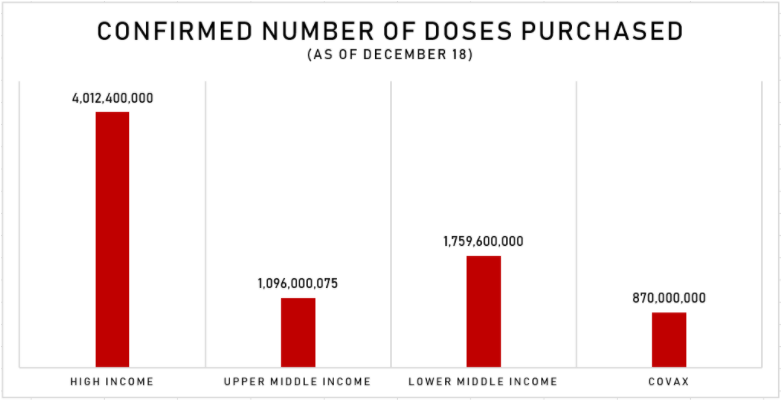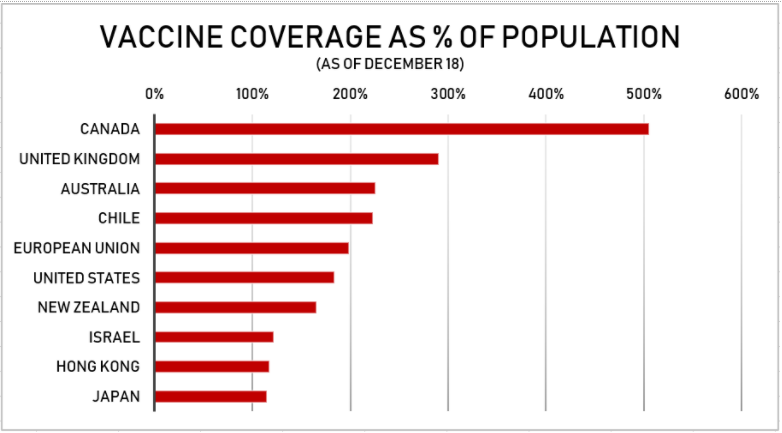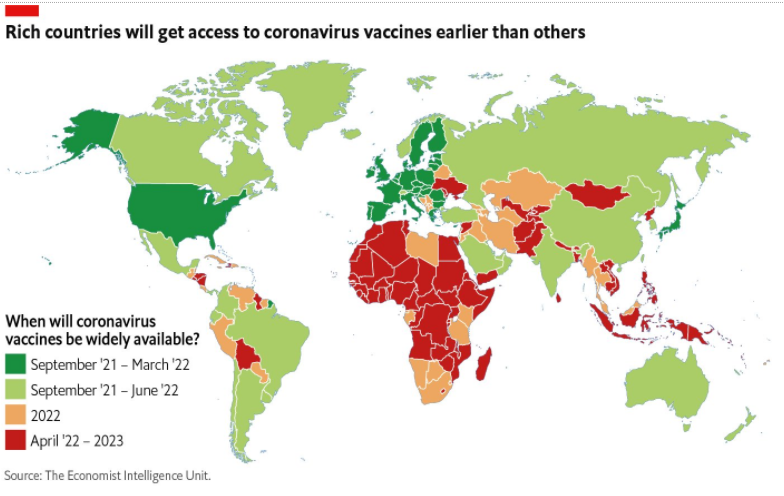Dissecting Data: How COVID-19 vaccine access is revealing truth about global pecking order
ADVERTISEMENT

Welcome, Kapamilya! We use cookies to improve your browsing experience. Continuing to use this site means you agree to our use of cookies. Tell me more!
Dissecting Data: How COVID-19 vaccine access is revealing truth about global pecking order
Warren de Guzman and Edson Guido,
ABS-CBN News
Published Dec 26, 2020 04:07 PM PHT
In early December, Philippine vaccine czar Secretary Carlito Galvez told the media during the Manila Bay Forum that “80 percent of the global market (for COVID-19 vaccines) has been taken by the rich countries. Now we are fighting for the 18 percent because COVAX has gotten the other two percent.”
In early December, Philippine vaccine czar Secretary Carlito Galvez told the media during the Manila Bay Forum that “80 percent of the global market (for COVID-19 vaccines) has been taken by the rich countries. Now we are fighting for the 18 percent because COVAX has gotten the other two percent.”
The COVAX initiative is a vaccination program of the World Health Organization meant to provide poorer nations access to COVID-19 vaccines. The Philippines is one of 92 low- and middle-income countries which will be supported by the COVAX Advance Market Commitment, based on a WHO release in August.
The COVAX initiative is a vaccination program of the World Health Organization meant to provide poorer nations access to COVID-19 vaccines. The Philippines is one of 92 low- and middle-income countries which will be supported by the COVAX Advance Market Commitment, based on a WHO release in August.
Galvez is essentially saying the developed world has hogged all COVID-19 vaccines, leaving little left for the rest of the world to haggle over.
Galvez is essentially saying the developed world has hogged all COVID-19 vaccines, leaving little left for the rest of the world to haggle over.
If Galvez is correct, that two percent of the market cornered by COVAX, which again styles itself as a global initiative aimed at working with vaccine manufacturers to provide countries worldwide equitable access to safe and effective vaccines, seems almost comically disproportionate.
If Galvez is correct, that two percent of the market cornered by COVAX, which again styles itself as a global initiative aimed at working with vaccine manufacturers to provide countries worldwide equitable access to safe and effective vaccines, seems almost comically disproportionate.
ADVERTISEMENT
A total of 172 economies are engaged to participate in COVAX, 92 of which are low- and middle-income countries. Is two percent of all available COVID-19 vaccines enough for that?
A total of 172 economies are engaged to participate in COVAX, 92 of which are low- and middle-income countries. Is two percent of all available COVID-19 vaccines enough for that?
Who is buying up all the vaccines? When can we expect Filipinos to be vaccinated? What costs are we looking at?
Who is buying up all the vaccines? When can we expect Filipinos to be vaccinated? What costs are we looking at?
Let’s dig into the numbers.
Let’s dig into the numbers.
First let’s look at the total available number of vaccines.
First let’s look at the total available number of vaccines.
As of December 18, data from the Duke Global Health Innovation Center showed over 7.7 billion COVID-19 vaccine doses have been purchased. If we assume these vaccines will require two doses per patient, as is the requirement for AstraZeneca and other vaccines, that is enough to cover half of the world’s population.
As of December 18, data from the Duke Global Health Innovation Center showed over 7.7 billion COVID-19 vaccine doses have been purchased. If we assume these vaccines will require two doses per patient, as is the requirement for AstraZeneca and other vaccines, that is enough to cover half of the world’s population.
ADVERTISEMENT
But that is only true if the vaccines are distributed equitably. The World Health Organization initiative in charge of equitable distribution, COVAX, is the smallest buyer out of the four categories. High income nations have bought up the most, snapping up over 4 billion doses, more than half of the total confirmed number of doses purchased.
But that is only true if the vaccines are distributed equitably. The World Health Organization initiative in charge of equitable distribution, COVAX, is the smallest buyer out of the four categories. High income nations have bought up the most, snapping up over 4 billion doses, more than half of the total confirmed number of doses purchased.
Vaccinations against COVID-19 have just started in parts of the world, yet the inequality in vaccine availability is already undeniable.
Vaccinations against COVID-19 have just started in parts of the world, yet the inequality in vaccine availability is already undeniable.
Who are these nations buying up COVID-19 vaccines?
Who are these nations buying up COVID-19 vaccines?
The United States and the European Union have bought enough vaccines to cover nearly twice their entire populations. The United Kingdom can do the same three times. Canada, which is known for its progressive, multicultural, generous, and humanitarian ideals, has bought enough to cover its population five times.
The United States and the European Union have bought enough vaccines to cover nearly twice their entire populations. The United Kingdom can do the same three times. Canada, which is known for its progressive, multicultural, generous, and humanitarian ideals, has bought enough to cover its population five times.
This might appear as a smart move since these vaccines are being bought without any guarantee they will work. Canada can safely say it has five shots at getting its COVID-19 vaccine right for its entire population, while the US and EU have two shots to do the same.
This might appear as a smart move since these vaccines are being bought without any guarantee they will work. Canada can safely say it has five shots at getting its COVID-19 vaccine right for its entire population, while the US and EU have two shots to do the same.
ADVERTISEMENT
However, this is also unfair considering COVID-19 vaccines, regardless of efficacy, are a scarce and precious resource. Buying up huge amounts of vaccine early is tantamount to robbing other nations of the opportunity to vaccinate against the virus.
However, this is also unfair considering COVID-19 vaccines, regardless of efficacy, are a scarce and precious resource. Buying up huge amounts of vaccine early is tantamount to robbing other nations of the opportunity to vaccinate against the virus.
In fairness to Canada, Prime Minister Justin Trudeau has said they would share excess doses if they have more than necessary. That means they want to make sure all Canadians are vaccinated before they start distributing extra doses elsewhere.
In fairness to Canada, Prime Minister Justin Trudeau has said they would share excess doses if they have more than necessary. That means they want to make sure all Canadians are vaccinated before they start distributing extra doses elsewhere.
The Philippine government has said it is fighting to bring COVID-19 vaccines that work to the archipelago by 2021. Galvez said the going has been tough. A "will they or won’t they" deal with Pfizer has been published extensively.
The Philippine government has said it is fighting to bring COVID-19 vaccines that work to the archipelago by 2021. Galvez said the going has been tough. A "will they or won’t they" deal with Pfizer has been published extensively.
WATCH:
A private sector initiative, the Go Negosyo AstraZeneca deal, has also faced criticism after a decision to skip in-country clinical trials. Organizers, however, still expect to push through.
A private sector initiative, the Go Negosyo AstraZeneca deal, has also faced criticism after a decision to skip in-country clinical trials. Organizers, however, still expect to push through.
This map by The Economist Intelligence Unit summarizes its assumptions on when vaccines are expected to be widely available for the general population of different countries. It shows that even the initial tranche of vaccines won’t be for everyone. It forecasts the wide distribution of COVID-19 vaccines will start by September 2021 at the earliest, and April 2022 to 2023 at the latest, depending on the nation.
This map by The Economist Intelligence Unit summarizes its assumptions on when vaccines are expected to be widely available for the general population of different countries. It shows that even the initial tranche of vaccines won’t be for everyone. It forecasts the wide distribution of COVID-19 vaccines will start by September 2021 at the earliest, and April 2022 to 2023 at the latest, depending on the nation.
ADVERTISEMENT
The Philippines is marked in red, putting it in the last category for wide vaccine distribution. The Economist has forecast the Philippines, alongside much of Southeast Asia, Africa, parts of South America, parts of Eastern Europe, parts of the Middle East, parts of the former Soviet Union in Central Asia, North Korea, and Mongolia would all be the last to enjoy wide distribution of COVID-19 vaccines.
The Philippines is marked in red, putting it in the last category for wide vaccine distribution. The Economist has forecast the Philippines, alongside much of Southeast Asia, Africa, parts of South America, parts of Eastern Europe, parts of the Middle East, parts of the former Soviet Union in Central Asia, North Korea, and Mongolia would all be the last to enjoy wide distribution of COVID-19 vaccines.
When it comes to COVID-19 vaccine availability, the Philippines, deemed one of the rising economic stars of Southeast Asia in 2019 thanks to its ascent towards an "A" credit rating and promising demographic dividend, has been lumped together with North Korea, which is facing steep economic sanctions from the international community, and Yemen, which is in the midst of a violent civil war.
When it comes to COVID-19 vaccine availability, the Philippines, deemed one of the rising economic stars of Southeast Asia in 2019 thanks to its ascent towards an "A" credit rating and promising demographic dividend, has been lumped together with North Korea, which is facing steep economic sanctions from the international community, and Yemen, which is in the midst of a violent civil war.
Whatever the reason, there is one thing that is clear. The Philippines has been left off the COVID-19 vaccine priority list.
Whatever the reason, there is one thing that is clear. The Philippines has been left off the COVID-19 vaccine priority list.
What do all the countries left off the vaccine priority list have in common? Money, or lack of it. This map from the Global Wealth Databook 2019, paints the world in terms of wealth.
What do all the countries left off the vaccine priority list have in common? Money, or lack of it. This map from the Global Wealth Databook 2019, paints the world in terms of wealth.
The darkest shades are the richest. The lightest shades are the poorest. Notice how the lighter shades on this map nearly matches the bright red on the vaccine availability map.
The darkest shades are the richest. The lightest shades are the poorest. Notice how the lighter shades on this map nearly matches the bright red on the vaccine availability map.
ADVERTISEMENT
Most of the nations who do not have early access to the COVID-19 vaccine have an average wealth per adult of below $25,000 or P1.2 million. The haves have it. The have nots don’t. Sec. Galvez was right.
Most of the nations who do not have early access to the COVID-19 vaccine have an average wealth per adult of below $25,000 or P1.2 million. The haves have it. The have nots don’t. Sec. Galvez was right.
Hedging bets on vaccines that have not been proven effective is all well and good. Purchasing huge amounts of vaccine when current models show that production won’t be enough to cover the entire population of the world until as late as 2023 or 2024 is just terrible. It is exclusive at best, and borderline genocidal at worst.
Hedging bets on vaccines that have not been proven effective is all well and good. Purchasing huge amounts of vaccine when current models show that production won’t be enough to cover the entire population of the world until as late as 2023 or 2024 is just terrible. It is exclusive at best, and borderline genocidal at worst.
The rest of the world needs to be given a shot at getting vaccinated so they could finally get past this global pandemic. Rich nations shouldn’t be buying up vaccines knowing full well they are taking away vaccine access from their poorer counterparts.
The rest of the world needs to be given a shot at getting vaccinated so they could finally get past this global pandemic. Rich nations shouldn’t be buying up vaccines knowing full well they are taking away vaccine access from their poorer counterparts.
Whether or not the vaccines work is beside the point. The rich are simply telling the rest of the world to get in line after them, and that shouldn’t be the case this late in human history.
Whether or not the vaccines work is beside the point. The rich are simply telling the rest of the world to get in line after them, and that shouldn’t be the case this late in human history.
If the Philippine government is having trouble procuring COVID-19 vaccines, Filipinos can expect more of the same, or worse. Filipinos with means won’t think twice about buying vaccines on their own.
If the Philippine government is having trouble procuring COVID-19 vaccines, Filipinos can expect more of the same, or worse. Filipinos with means won’t think twice about buying vaccines on their own.
ADVERTISEMENT
The largest corporations have already acted ahead of the Philippine government. Those without the means to get their own vaccines will no doubt be left out in the cold. It’s a safe bet these same Filipinos don’t have insurance coverage, or even jobs due to the pandemic-induced recession. The COVID-19 pandemic widened the class divide in the Philippines, and those on the wrong end of the spectrum will now be forced to face the virus for years without access to vaccines.
The largest corporations have already acted ahead of the Philippine government. Those without the means to get their own vaccines will no doubt be left out in the cold. It’s a safe bet these same Filipinos don’t have insurance coverage, or even jobs due to the pandemic-induced recession. The COVID-19 pandemic widened the class divide in the Philippines, and those on the wrong end of the spectrum will now be forced to face the virus for years without access to vaccines.
As a final point, vaccinating an entire population should in theory protect that population from COVID-19. But it would depend on the efficacy of the vaccine and the absence of mutations that would render such vaccines ineffective. Would that population really feel safe if the rest of the world was full of unvaccinated individuals, walking petri dishes for fresh COVID mutations?
As a final point, vaccinating an entire population should in theory protect that population from COVID-19. But it would depend on the efficacy of the vaccine and the absence of mutations that would render such vaccines ineffective. Would that population really feel safe if the rest of the world was full of unvaccinated individuals, walking petri dishes for fresh COVID mutations?
Wouldn’t it be better if every single individual was vaccinated against the disease? Past diseases such as polio and smallpox were only successfully defeated through globally coordinated mass vaccinations. Conversely, such viruses have only made comebacks after certain parties actively campaigned against vaccination. COVID-19 is a global pandemic that has killed millions. It won’t likely be defeated without a global effort. Any nation, or individual left unvaccinated or unprotected leaves the world vulnerable to another outbreak or pandemic.
Wouldn’t it be better if every single individual was vaccinated against the disease? Past diseases such as polio and smallpox were only successfully defeated through globally coordinated mass vaccinations. Conversely, such viruses have only made comebacks after certain parties actively campaigned against vaccination. COVID-19 is a global pandemic that has killed millions. It won’t likely be defeated without a global effort. Any nation, or individual left unvaccinated or unprotected leaves the world vulnerable to another outbreak or pandemic.
It is worth repeating.
It is worth repeating.
Everyone deserves a shot at COVID-19 immunity.
Everyone deserves a shot at COVID-19 immunity.
ADVERTISEMENT
Vaccines should not be reserved for the rich.
Vaccines should not be reserved for the rich.
Read More:
ABS-CBN Data Analytics
COVID-19
Economic Recovery
Vaccines
COVID-19 vaccines
bakuna kontra COVID-19
coronavirus pandemic
pandemic
vaccine
dissecting data
ADVERTISEMENT
ADVERTISEMENT






.png)